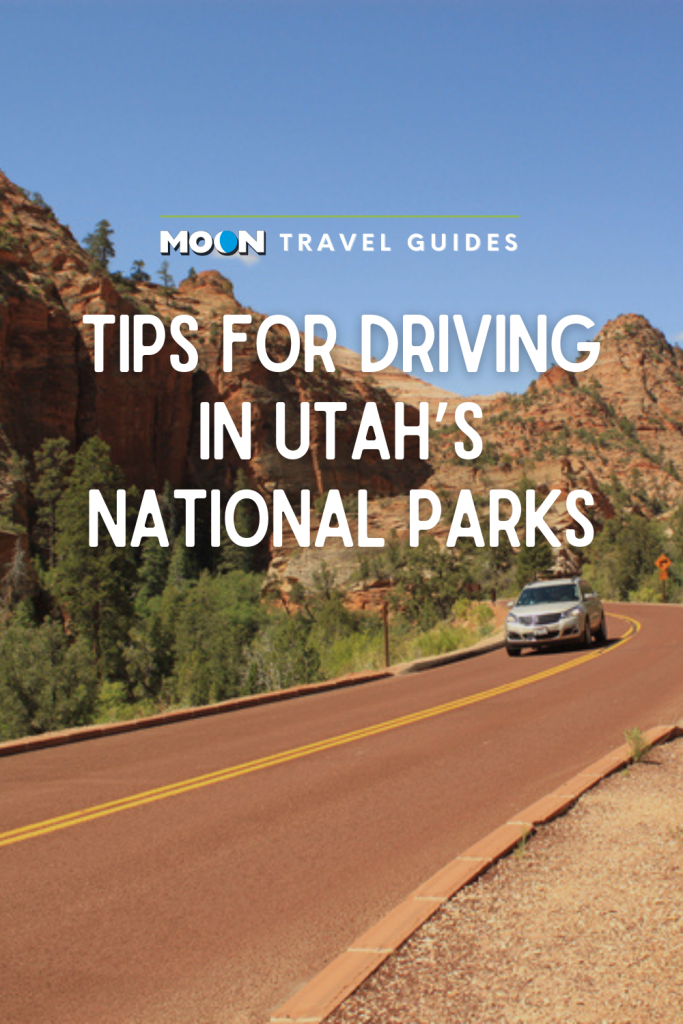Tips for Driving in Utah’s National Parks
During summer, patience is key to enjoying your drive through Utah’s national parks. Roads are often crowded with slow-moving RVs, and traffic jams are not uncommon.

If you’re traveling on back roads, especially in the Grand Staircase-Escalante area, make sure you have plenty of gas, even if it means paying top dollar at a small-town gas pump.
Summer heat in the desert puts an extra strain on both cars and drivers. It’s worth double-checking your vehicle’s cooling system, engine oil, transmission fluid, fan belts, and tires before a big drive. Carry several gallons of water in case of a breakdown or radiator trouble. Never leave children or pets in a parked car during warm weather—temperatures inside can cause fatal heatstroke in minutes.
At times, the desert has too much water. When late-summer storms strike, low spots in the road frequently flood. Wait for the water level to subside before crossing. Dust storms can completely block visibility but tend to be short-lived. During such storms, pull completely off the road, stop, and turn off your lights so as not to confuse other drivers. Radio stations carry frequent weather updates when weather hazards exist.
If stranded, stay with your vehicle unless you’re confident about where to go for help, then leave a note explaining your route and departure time. Airplanes can easily spot a stranded car (tie a piece of cloth to your antenna), but a person walking is more difficult to see. It’s best to carry emergency supplies: blankets or sleeping bags, a first-aid kit, tools, jumper cables, a shovel, traction mats or chains, a flashlight, rain gear, water, food, and a can opener.
Maps
The Utah Department of Transportation prints and distributes a free, regularly updated map of Utah. Ask for it when you call for information or when you stop at a visitor information office. Benchmark Maps’ Utah Road and Recreation Atlas is loaded with beautiful maps, recreation information, and global positioning system (GPS) grids. If you’re planning on extensive backcountry exploration, be sure to ask locally about conditions.
If you’re looking for USGS topo maps, you can download them for free at www.topozone.com.
Off-Road Driving in Utah
Here are some tips for safely traversing the backcountry in a vehicle (preferably one with four-wheel drive):
- Drive slowly enough to choose a safe path and avoid obstacles like rocks or giant potholes, but maintain enough speed to propel your vehicle through sand or mud.
- Keep an eye on the route ahead of you. If there are obstacles, stop, get out of your vehicle, and survey the situation.
- Reduce tire pressure if you’re driving across sand.
- Drive directly up or down the fall line of a slope. Cutting across diagonally may seem less frightening, but it puts you in a position to slide or roll over.
If you really want to learn to drive your 4WD rig, consider signing up for a class.
Charging Your Electric Car
Electric vehicle (EV) charging stations are present in some areas of southern Utah, but if you plan to explore far-flung destinations, a little preplanning is in order. EV charging stations are available in St. George, Cedar City, Springdale, the visitor center at Zion National Park, Ruby’s Inn (near Bryce Canyon National Park), Green River, St. George, Kanab, Boulder (at Boulder Mountain Lodge), Moab, Blanding, and Page, Arizona. That leaves big areas of southeast Utah with no EV charging services, so do the math and plan your route beforehand to avoid getting stranded.
Related Travel Guide
Spark your sense of wonder and immerse yourself in the awe-inspiring landscape of Utah’s five national parks.
Newsletter Signup
By clicking ‘Sign Up,’ I acknowledge that I have read and agree to Hachette Book Group’s Privacy Policy and Terms of Use
Pin It for Later


